 Salvador Dali's work yields to archetypal dream analysis. Through much of it an older European age is yielding and a new age ascends. Taken as a whole it becomes clear that life begins again as a new Creation on a new continent in Texas.
Salvador Dali's work yields to archetypal dream analysis. Through much of it an older European age is yielding and a new age ascends. Taken as a whole it becomes clear that life begins again as a new Creation on a new continent in Texas.Note: The painting of the Buddhist monk by dali at the bottom is called "The SEcond Coming of Christ."
A few introductory notes on dreams: To understand your dreams, there is no other way. You must start from where you are. Now is as good a time as any, and it is perhaps a
 much better time than 50 or 100 years ago. There are a lot more resources available now. You can learn knowledge of dreams today from Native American sources, from the Kabala, from Tibetan Buddhism and Theravada Buddhism – which travels smoothly from Vedic to Buddhist without breakage in places all over Southeast Asia and into
much better time than 50 or 100 years ago. There are a lot more resources available now. You can learn knowledge of dreams today from Native American sources, from the Kabala, from Tibetan Buddhism and Theravada Buddhism – which travels smoothly from Vedic to Buddhist without breakage in places all over Southeast Asia and into On-line now are a variety of dream forums which offer the Blue Plate Special. It is like going to the mall to find your true love. It is possible you will find him there, but not likely. Then again, remember that the gods always hide in the lowest places – malls, beat-up
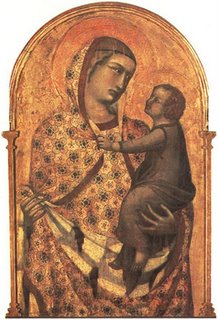 Avoid two things: the Mister Potato Head treatment – the notion that in a single dream you are finding all the different components; your female side, or anima, masculine side, or animus, dark side, Self, Psyche and the Monkey God to boot. This will be a lifetimes’ journey and then it will be only a very small and partial journey. Dreams of Cosmic consequence tell a story and the story usually has a beginning, a middle and an end and sometimes goes on for several years or longer. Then other times it is all in one night or one moment, as in Black Elk’s great vision. I would avoid psychologists, and never pay to have someone tell you what your dream means. It is one of the things in life you don’t pay for. The culture is plagued with neurosis, and neurosis is generally dispersed generationally (or in a multi-generational pattern), not individualized. In my opinion, the greatest affliction today is Infantilism – the inner child theme. Like alcoholism or drug use, it reverts people back to childhood and MOTHER and prevents them from pushing on to the long and changing arc of adulthood and an honest death. This magnificent portrait above of Madonna and Child (1320) by Pietro Lorenzetti, expresses the cosmic life - the yin and yang - of the Western trajectory up until the 14th century – all the Extraverted Karma is in the yin, the Earth Mother or the
Avoid two things: the Mister Potato Head treatment – the notion that in a single dream you are finding all the different components; your female side, or anima, masculine side, or animus, dark side, Self, Psyche and the Monkey God to boot. This will be a lifetimes’ journey and then it will be only a very small and partial journey. Dreams of Cosmic consequence tell a story and the story usually has a beginning, a middle and an end and sometimes goes on for several years or longer. Then other times it is all in one night or one moment, as in Black Elk’s great vision. I would avoid psychologists, and never pay to have someone tell you what your dream means. It is one of the things in life you don’t pay for. The culture is plagued with neurosis, and neurosis is generally dispersed generationally (or in a multi-generational pattern), not individualized. In my opinion, the greatest affliction today is Infantilism – the inner child theme. Like alcoholism or drug use, it reverts people back to childhood and MOTHER and prevents them from pushing on to the long and changing arc of adulthood and an honest death. This magnificent portrait above of Madonna and Child (1320) by Pietro Lorenzetti, expresses the cosmic life - the yin and yang - of the Western trajectory up until the 14th century – all the Extraverted Karma is in the yin, the Earth Mother or the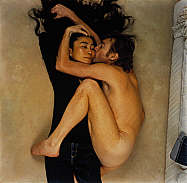 Cosmic Mother, while the Introverted Karma is in the yang, the Cosmic Child (in Lorenzetti's picture he is even darkened, in shadow, as the yang force was submissive to the yin force until the 1500s) – and notice how Lorenzetti's picture resembles our own Cosmic Child on the last day of his life – notice as well that his wife chose to wear black on the morning it was taken. But in this historic photo, Yoko's Cosmic Child is full of light, and Earth Mother has returned to shadow. Annie Leibovitz had taken a similar picture years before, but Yoko Ono was naked. The Cosmic Child is the Hindu archetype of the Deathless Child – the Taoist avatar, like the Christ Child and the Star Child, born every year to the Earth Mother on Winter Solstice. To see with the vision of this Avatar is to see "as a Child." To see "like a child” is the neurosis of Infantilism.
Cosmic Mother, while the Introverted Karma is in the yang, the Cosmic Child (in Lorenzetti's picture he is even darkened, in shadow, as the yang force was submissive to the yin force until the 1500s) – and notice how Lorenzetti's picture resembles our own Cosmic Child on the last day of his life – notice as well that his wife chose to wear black on the morning it was taken. But in this historic photo, Yoko's Cosmic Child is full of light, and Earth Mother has returned to shadow. Annie Leibovitz had taken a similar picture years before, but Yoko Ono was naked. The Cosmic Child is the Hindu archetype of the Deathless Child – the Taoist avatar, like the Christ Child and the Star Child, born every year to the Earth Mother on Winter Solstice. To see with the vision of this Avatar is to see "as a Child." To see "like a child” is the neurosis of Infantilism.
In the current mischief, the “inner child” becomes the neurosis and perhaps an entire generation suffers from it. C.G. Jung warned against the “inner child” as someone weak in spirit – and one is weakened in the spirit when he goes to a shrink – will not see “as a child sees” as Jesus came to after Cosmic Trasfiguation and as a Buddha does after Enlightenment, but “like a child” – reverting further to adolescence and irresponsibility. It is like recommending drug use or heavy drinking to make your pain go away. And like Heavy Drinking and Drug Use, it does work in making the pain go away, but it takes you off your path. The Pain you feel is the future ahead of you and your Unfolding into It – you’re finding your Way in the Creation. Avoid the Blue Plate Special.
There are two kinds of dreams – the first is a dream of being on the second floor of a building and wanting to be on the eighth floor. These are nervous dreams about everyday life – of wanting to get a promotion at work; the waiter's dream of forgetting to give a customer his cup of coffee the day before, the young professor intimidated by an upcoming lecture she or he must give and dreaming he is naked before a class; a dream of nails in your hands and feet when you have been “crucified” – treated arbitrarily and unfairly by a pedantic teacher, parole officer or wicked nun. These are dreams about the stresses of everyday life.
The other kind of dream is a calling from God to lead you to the path of wholeness – with yourself and with your community – at best, with God, and with the Universe. This is the Zen path, the Taoist path - in translation from the text The Tao te Ching, it is The Path of Integrity. You can learn to understand your dreams in a variety of ways, but most important you must see that dreams are not a separate part of your life. They are a most important part of your live, like love and the responsibility which associates itself with love. It is a life-long path and if you drop the ball one time you’re screwed.

 Throughout his life Dali was inspiried by the South Lipez Desert in Potasi, Bolivia, and som eof his best known paintings take their background from that region. One of his most well known pictures, Soft Construction with Boiled Beans (Premonition of Civil War), 1936,
Throughout his life Dali was inspiried by the South Lipez Desert in Potasi, Bolivia, and som eof his best known paintings take their background from that region. One of his most well known pictures, Soft Construction with Boiled Beans (Premonition of Civil War), 1936, clearly takes an inspiration from this rock formation photographed by Maurice van Niekerk.
clearly takes an inspiration from this rock formation photographed by Maurice van Niekerk.
He also had a lifelong fascination with the New World and the North and South American continents. Dali spent years in the United States and painted many psychological impressions. Various elements live inthe desert and they can be seen connected by elements they share. The picture at top, for example, has a Knight on Horseback - a Skeleton; a KNight from The Land of the Dead. I have dreamed of such a character in my own dreams. Very often it is a messenger - a connector between the Everyday life and the Cosmic life. In Star Wars, a Jedi, who has powers both mortal and cosmic. In the terms of early Christianity, a Knight Templar - illustrated by two on a horse, as he has dual nature, human and Cosmic. This archetype is best described by Lao Tsu in the Tao te Ching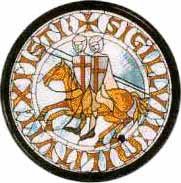 as a "Knight Scholar of Dark and Mysterious Consequence." He rides in the Unconscious and he rides in real life. Lao Tsu mourns his passing in the Tao de te Ching, and laments that now his presence is gone from the earth - now we will have to draw up rules to live by. (We have lost our Intuition to the Inner Life.)
as a "Knight Scholar of Dark and Mysterious Consequence." He rides in the Unconscious and he rides in real life. Lao Tsu mourns his passing in the Tao de te Ching, and laments that now his presence is gone from the earth - now we will have to draw up rules to live by. (We have lost our Intuition to the Inner Life.)
 Clearly Dali's Knight here comes from The Land of the Dead and the landscape suggests a world that is dying. But behind the screen of nature - and such a screen like this is a common element in dreams - there is new life and a rainbow. The Horseman from the Unconscious faces and points left of screen, which always in organic life, be it Dali or Mother Whistler, points to the Inner World and to the Inner Life. Surely this Horseman is a Spectre of Death, but Death in a dream, is often a
Clearly Dali's Knight here comes from The Land of the Dead and the landscape suggests a world that is dying. But behind the screen of nature - and such a screen like this is a common element in dreams - there is new life and a rainbow. The Horseman from the Unconscious faces and points left of screen, which always in organic life, be it Dali or Mother Whistler, points to the Inner World and to the Inner Life. Surely this Horseman is a Spectre of Death, but Death in a dream, is often a birth. And what appears frightening is auspicious (as novelist Gretel Erlick points out, " . . . the smae ship that brings out the Dead bring in the Birth.") This is the way of Dreams.
birth. And what appears frightening is auspicious (as novelist Gretel Erlick points out, " . . . the smae ship that brings out the Dead bring in the Birth.") This is the way of Dreams.
 This figure will appear again in Dali's work, and in a more healthy state. Here is is in 1932, The Knight at the Tower. But in The Horseman of Death (above), in 1935, he brings the shadow of war falling across Europe. Giorgio De Chrico, forerunner of the Surrealists, painted Towers as well, in red and white and in the same time period. But I don't feel that De Chirico fully solved his riddle. Dali did.
This figure will appear again in Dali's work, and in a more healthy state. Here is is in 1932, The Knight at the Tower. But in The Horseman of Death (above), in 1935, he brings the shadow of war falling across Europe. Giorgio De Chrico, forerunner of the Surrealists, painted Towers as well, in red and white and in the same time period. But I don't feel that De Chirico fully solved his riddle. Dali did.
Here is a third picture with the same elements, and filled with other stuff as well. In 1943, in this painting called Poetry of America, the Knight has completed his journey.
 This is an unfinished painting, but as is it speaks volumes. First of all, the Knight, whom we ahve seen in at least two paintings has become real in the world. Waht was in the Unconscious trying to become real has arrived. The Knight is no longer on garde in armor or on horseback, be is sitting passively. The Creation has arrived. The Avatar like Kao Ste's Daark and Mysterious Knight, no longer has a role. We know he is the Knight because he still holds the staff and the tower is still present. And as the Knight has lost his individuated Cosmic nature and is now naked, the Tower is fully developed. But there is a new Avatar in this picture. The man on the right. And he is the Christ. The Christ in a new land in a new age. And we know from his wound that he is in Texas.
This is an unfinished painting, but as is it speaks volumes. First of all, the Knight, whom we ahve seen in at least two paintings has become real in the world. Waht was in the Unconscious trying to become real has arrived. The Knight is no longer on garde in armor or on horseback, be is sitting passively. The Creation has arrived. The Avatar like Kao Ste's Daark and Mysterious Knight, no longer has a role. We know he is the Knight because he still holds the staff and the tower is still present. And as the Knight has lost his individuated Cosmic nature and is now naked, the Tower is fully developed. But there is a new Avatar in this picture. The man on the right. And he is the Christ. The Christ in a new land in a new age. And we know from his wound that he is in Texas.
I find the tower to be interesting. It looks very like the clock tower at The University of Mighigan at Ann Arbor, one of my favorite places - partly because of the architecture of the campus. The style of Albert Kahn pervades the U. Michigan campus as it does Dearborn and Detroit. It represetns he new age of America as Ford did to Aldous Huxley, both with its light and dark side. It is the Power Principle fully incarnate - a man dancing with a another man - like Hegelian thesis and counterthesis, there is no yin present in the new age. There is only yang plus and yang minur - two male characters dancing. (Interesting, as Albert Kahn advanced the modernist perspective in Detroit, his brother did in Moscow - Hegel's force and counter-force; Two Men Dancing - Communist and Capitalists.).
There are elements in this picutre which work much as dreams work - a person will dream of a figure one night, and later it will develop or discinteegrate, but its nature will change one way or another. We know it is the Christ from another picture - and we learn form this picture that it is the Christ in the other picture, because of the nature of the wound in this picture. The would in the figure on the right is where Christ was wounded with the spear on Calvary. We know also by the candle in his head that he is the Enlightened One. and in this popular and remarkable work, Geopolitical Child Watching the Birth of the New Man, painted in 1943, same year as Poetry of America, we see that the oil is blood. Between the two pictures we know that the New Man - the Aquarian - is the Christ.
remarkable work, Geopolitical Child Watching the Birth of the New Man, painted in 1943, same year as Poetry of America, we see that the oil is blood. Between the two pictures we know that the New Man - the Aquarian - is the Christ.
This is an important painting. Geopoliticus Child in America will be a basketball player. The Christ will fall into shadow, as in the Lorenzetti painting of 1320. The cleansing blood of Christ upon the earth is a oil slick carrying a coke bottle and a telephone. But this picture tells us something else. It tells us that we have entered time. And the hole in the egg/globe - the hatching in the new world is presented at the top of the tower as a clock. - the age has begun and is upon us.
I have seen the form hanging from the clock refered to as Africa by museum curators and writers, but I don't know why. It would seem that it was similar to taking the picutre out of context of the others. There are a good number of Dali's paintings of the North and South American continents with the North illustrated as a hole or an egg cracking - a birth image, and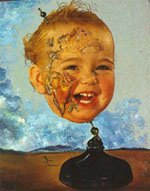 th eSouth dangling form it. Geopoliticus Child is the most prominent one. In 1949, in Baby Map of the World, he is ready for first steps. All these pictures appear to have the Andes and Patagonia trailing on the left.
th eSouth dangling form it. Geopoliticus Child is the most prominent one. In 1949, in Baby Map of the World, he is ready for first steps. All these pictures appear to have the Andes and Patagonia trailing on the left.
All these pictures suggest the United States is a world being born again in a new age.
The oil flow in Poetry in America divides the U.S. as the Mississippi does, and pools in what ws considered the great source of oil in the 1940s, Texas. This would be the dance of the millenia ahead, that between the one on the one Coast, and that on the other. High on top would be the Tower, and below, the Desert.
What is more: as in the piano paintings, Dali brings Pegasus, the harbninger of Aquarius into the picture. IN 1941 he was invited to participate in a contest to make a picture of hte classic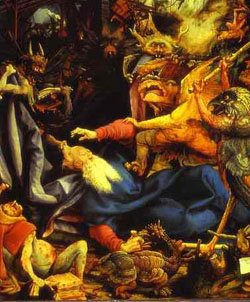 vision of the Western spirit rising out of the earth, the womb of the Earth Mother, and finding its new consciousness. The Temptation of St. Anthony marks the transition from Maedeval age and the Earth Mother consciousness, to the Renaissance and the rising vision of the Enlightenment. Sassetta has him leaving a cave in the earth in trepidation in the early 1400s and Matthias Grunewald his him torn apart by beasts in the early 1500s.
vision of the Western spirit rising out of the earth, the womb of the Earth Mother, and finding its new consciousness. The Temptation of St. Anthony marks the transition from Maedeval age and the Earth Mother consciousness, to the Renaissance and the rising vision of the Enlightenment. Sassetta has him leaving a cave in the earth in trepidation in the early 1400s and Matthias Grunewald his him torn apart by beasts in the early 1500s.
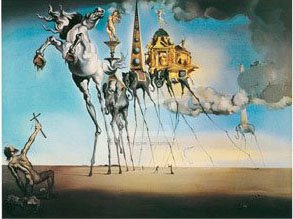 Dali brings in Pegasus, carrying Rome with him to the Desert.
Dali brings in Pegasus, carrying Rome with him to the Desert.
From beginning to end, the Surrealists were on a spiritual quest, but an unconventional kind. Andre Breton wrote poems indedication to the 13th Dalai Lama. These is continuity today with artist, asa all organic and true artists are related. In recent years Yoko Ono and her son Sean participated in a concert for the benefit of The Campaign in Tibet. As mentioned before,
son Sean participated in a concert for the benefit of The Campaign in Tibet. As mentioned before,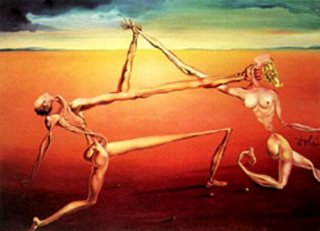 Dali was fascinated with pop music and found it in the Unconscious where the Knight on Horseback lives, identified by a white grand piano. In 1957, it came from behind the curtain ( which seperates the quick from the Land of the Dead - and here in this picture critters are from the Dead/the Unconscious and In Between). Same year he sent it to the American desert - that would be the Texas Desert, still with a trace of the hills in the background of Poetry in America, but now in full daylight - where the oil was thought to be in this painting titled Rock 'n Roll.
Dali was fascinated with pop music and found it in the Unconscious where the Knight on Horseback lives, identified by a white grand piano. In 1957, it came from behind the curtain ( which seperates the quick from the Land of the Dead - and here in this picture critters are from the Dead/the Unconscious and In Between). Same year he sent it to the American desert - that would be the Texas Desert, still with a trace of the hills in the background of Poetry in America, but now in full daylight - where the oil was thought to be in this painting titled Rock 'n Roll.
 Of course the Orange Monk, Dali's Aquarian avatar, landed in the desert as well - a desert on the edge of pasture and hinterland. Notice the common compositional elements with above paintings Geopolitical Child and Poetry in America; water flows from Pegasus dividing the painting, as oil and blood flow from the Christ figures above in Geopolitical Child and Poetry in America. The Horse dripping fluid centers the compostion as the Egg/Dancer with Candle dripping fluid does in the others. The connected secondary figures in Geopolitical Child and Poetry in America evolve to a dual dragon here, connected in all three paintings. This picture advances all themes in those paintings and forms a sequence with the earlier Tower painting. The new avatar, the Orange Monk, emerges from the Christ wound in the flying horse, Pegasus - the Christ in the above painting. The appearance of the dual dragons signifies a new creation (Khrishna holding the two eggs - Arthur and the two dragons). (Note: Pegasus, the flying horse, is in mythic terms the harbinger of the Age of Aquarius; see Jung, here. Orange Monk was painted in 1971. In 1930, Pegasus shed his skin, the sign of "new creation" - see reader's dream here for discussion - and took to the sky from a grand piano, played by a piano player who had two heads; dual nature - man and lion god - in Dali's great work, William Tell. See White Grand Piano for discussion.)
Of course the Orange Monk, Dali's Aquarian avatar, landed in the desert as well - a desert on the edge of pasture and hinterland. Notice the common compositional elements with above paintings Geopolitical Child and Poetry in America; water flows from Pegasus dividing the painting, as oil and blood flow from the Christ figures above in Geopolitical Child and Poetry in America. The Horse dripping fluid centers the compostion as the Egg/Dancer with Candle dripping fluid does in the others. The connected secondary figures in Geopolitical Child and Poetry in America evolve to a dual dragon here, connected in all three paintings. This picture advances all themes in those paintings and forms a sequence with the earlier Tower painting. The new avatar, the Orange Monk, emerges from the Christ wound in the flying horse, Pegasus - the Christ in the above painting. The appearance of the dual dragons signifies a new creation (Khrishna holding the two eggs - Arthur and the two dragons). (Note: Pegasus, the flying horse, is in mythic terms the harbinger of the Age of Aquarius; see Jung, here. Orange Monk was painted in 1971. In 1930, Pegasus shed his skin, the sign of "new creation" - see reader's dream here for discussion - and took to the sky from a grand piano, played by a piano player who had two heads; dual nature - man and lion god - in Dali's great work, William Tell. See White Grand Piano for discussion.)
Texas and its desert is a place at once primal and sacred and it is stuck in between the Western world and the Eastern world. It is a desert in the center of the world. In the 1950s the story was told of a Texas Ranger who died/was killed and was brought back to life ("born again") by an Indian. The common parlance has it that this Indian, Tonto, the Ranger's side kick, was a submissive underling, shoeing his horses and polishing his Silver Bullets. This is the work of Revenge Demons (Where is Buffy when you need her?). In actuality, an Indian in a secondary role like this - be it in Cooper's Leatherstocking tales or in the episode of The X Files where Fox Mulder is guided through the Land of the Dead - is an avatar or spirit guide to the white man who has lost his Euro ways but not yet found full psychic footing in the new land. This is the primary myth of the North American condition.
Demons (Where is Buffy when you need her?). In actuality, an Indian in a secondary role like this - be it in Cooper's Leatherstocking tales or in the episode of The X Files where Fox Mulder is guided through the Land of the Dead - is an avatar or spirit guide to the white man who has lost his Euro ways but not yet found full psychic footing in the new land. This is the primary myth of the North American condition.
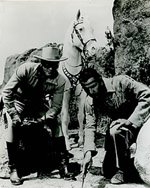 The white man wears a mask. His identity is not revealed. Weekly we were asked on American TV when Dali was making these paintings, "Who is that Masked Man?"
The white man wears a mask. His identity is not revealed. Weekly we were asked on American TV when Dali was making these paintings, "Who is that Masked Man?"

No comments:
Post a Comment